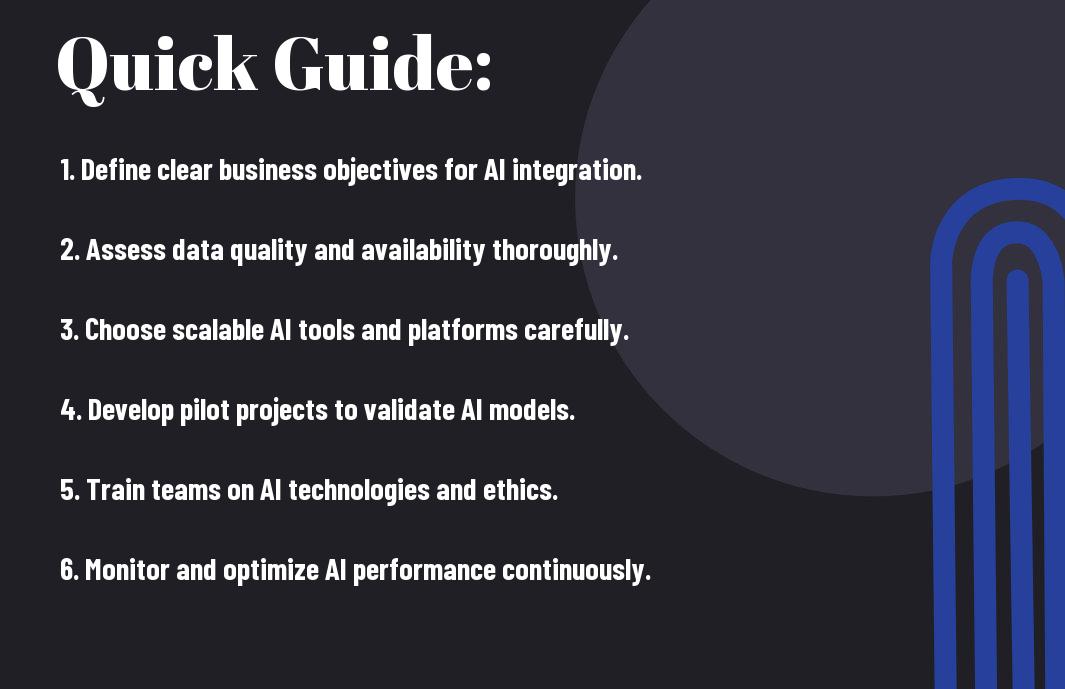BestPractices in implementing Enterprise AI can significantly transform your business processes and enhance operational efficiency. This guide will equip you with imperative steps to integrate AI successfully within your organization, covering best practices as well as recommending effective tools. You will learn how to navigate potential challenges and leverage AI to drive innovation and achieve your strategic objectives. With the right approach, you can maximize the benefits of AI while minimizing associated risks.
Key Takeaways:
- Define clear objectives and metrics before starting an AI project to ensure alignment with business goals and measurable outcomes.
- Choose the right tools and frameworks that fit the specific needs of your organization, considering scalability, ease of integration, and support for collaboration.
- Invest in training and change management to equip employees with the necessary skills and foster a culture that embraces AI technologies.
Crafting a Strategic Vision for AI Integration
Developing a clear and compelling strategic vision for AI integration sets the stage for successful deployment across your organization. This vision should articulate how AI aligns with your overall business strategy, addressing both current challenges and future aspirations. By engaging key stakeholders early in the process and defining a roadmap, you empower your teams to embrace AI technologies that will enhance productivity, drive innovation, and ultimately lead to a competitive advantage in your industry.
Aligning AI Goals with Business Objectives
Your AI initiatives should directly support your broader business objectives to ensure alignment and maximize impact. This involves analyzing how AI can address pain points across various departments, such as improving customer service through chatbots or optimizing supply chain management with predictive analytics. By establishing clear connections between AI projects and your organization’s goals, you create a framework that fosters collaboration and drives commitment from teams across the board.
Setting Realistic Expectations and Metrics
Successful AI integration hinges on setting achievable expectations and metrics for performance evaluation. Rather than pursuing ambitious goals that could obscure the value of AI implementations, focus on incremental progress. Identify key performance indicators (KPIs) relevant to each AI project, including cost savings, efficiency improvements, and user satisfaction ratings. This approach will not only facilitate tracking but also provide valuable insights that can guide adjustments as your organization evolves in its AI journey.
Establishing realistic expectations also means understanding the limitations of AI technologies and the timeframe required for meaningful outcomes. For example, while you may aim for a substantial reduction in operational costs through automation, it’s vital to break this goal into smaller, measurable steps. You might initially seek a 10% increase in efficiency in a specific process before scaling further. By regularly reviewing and communicating these metrics to all stakeholders, you pave the way for sustained momentum and a culture of continuous improvement in your AI initiatives.

Assessing Organizational Readiness for AI
Assessing your organization’s readiness for AI is important to ensure that you can effectively implement the technology and achieve desired results. Understanding the current state of your processes, culture, and technology infrastructure can help highlight areas that need improvement. By systematically evaluating these elements, you set a solid foundation for successful AI integration. For an in-depth look at navigating this journey, refer to Enterprise AI: What It Is, How To Implement, Examples.
Evaluating Data Infrastructure and Quality
Strong data infrastructure and quality are the backbone of any AI initiative. You should assess whether your organization has the proper systems in place to collect, store, and manage data effectively. This involves evaluating data sources, storage capabilities, and analytics tools to ensure they meet the complexities of AI algorithms. If your data is siloed, incomplete, or of low quality, AI won’t deliver reliable insights.
Identifying Skill Gaps and Training Needs
Conducting an assessment of your team’s skills helps identify gaps that may hinder AI implementation. This involves analyzing the existing expertise related to AI technology, data science, and machine learning. You may find that your team needs training in specific tools, programming languages, or frameworks commonly used in AI projects.
Identifying skill gaps and training needs entails a detailed examination of roles within your organization. You might discover that while some employees excel in traditional analytics, they lack knowledge in AI-specific models or programming tools like Python or R. Providing targeted training, workshops, and resources could significantly enhance their capabilities, ensuring that your team is well-equipped to tackle complex AI projects successfully. Engaging with external partners or consultants can also add value, allowing your team to gain insights from seasoned professionals while fostering an organizational culture that is ready to embrace AI technologies.
Selecting the Right Tools and Technologies
Choosing the appropriate tools and technologies for your enterprise AI initiative can greatly impact its success. Focus on solutions that align with your organization’s specific needs, ensuring compatibility with existing systems. Look for platforms that provide robust support, community engagement, and a rich ecosystem that can cater to various applications, from machine learning to natural language processing.
Comparing Leading AI Platforms and Frameworks
Leading AI platforms and frameworks vary in features, ease of use, and support structures. The table below offers a comparison of several renowned options:
| TensorFlow | Open-source, supports deep learning, strong community support |
| PyTorch | Dynamic computation graph, widely used in academia, flexible and intuitive |
| Microsoft Azure AI | Integrated services for machine learning, cognitive services, and easy scalability |
| IBM Watson | Data processing, natural language understanding, industry-specific models |
Considerations for Scalability and Security
Scalability and security should be top priorities when selecting AI technologies. Solutions must not only accommodate your current data workloads but also be able to grow as your business needs evolve. In considering security, prioritize platforms that offer robust encryption, identity management, and compliance with industry regulations.
To ensure scalability, look for tools that provide tools for distributing workloads across servers and optimizing resource allocation. In terms of security, investigate the security protocols and compliance standards followed by potential vendors, particularly if dealing with sensitive data. Assessing these aspects upfront can prevent future complications and empower your AI initiatives to adapt seamlessly as your organization expands.

Building an Agile Implementation Framework
An agile implementation framework allows you to swiftly iterate and adapt your AI strategies based on real-time feedback and changing business requirements. By incorporating flexibility into your processes, you can accelerate deployment times while enhancing your ability to pivot toward opportunities and mitigate risks. Emphasizing iterative cycles, continuous improvements, and stakeholder feedback ensures that your AI initiatives remain aligned with your strategic vision and organizational goals.
Developing a Pilot Project Roadmap
A well-structured pilot project roadmap serves as a foundation for testing your AI initiatives in a controlled environment. Start by defining the objectives and scope of the pilot, identifying key performance indicators (KPIs) to measure success, and determining necessary resources. Outline timelines and responsibilities to maintain accountability and ensure that your team can effectively address any challenges that arise during the pilot phase.
Ensuring Cross-Disciplinary Stakeholder Engagement
Engagement from diverse stakeholders is fundamental to the success of your AI integration efforts. You need input from various departments, including IT, marketing, operations, and human resources, to align your AI strategy with broader business objectives. This collaborative approach fosters a sense of ownership and inclusivity, driving greater support for the implementation process. Regular meetings and workshops facilitate open communication, allowing stakeholders to share valuable insights and concerns early in the development phase.
Involving stakeholders from different disciplines not only enriches the decision-making process but also uncovers unique perspectives that contribute to your project’s success. For instance, IT specialists may identify technical constraints, while marketing teams can provide insight into customer needs and preferences. Organizations that prioritize cross-disciplinary collaboration see 30% higher project success rates, showcasing the impact of diverse input in shaping effective AI solutions. By fostering an environment of cooperation and shared goals, you set the stage for both innovation and accountability in your AI implementation journey.
Navigating Ethical Considerations in AI Deployment
Successful AI deployment requires a deep understanding and consideration of the ethical implications surrounding your models and algorithms. Developing guidelines that prioritize transparency, fairness, and accountability will not only foster trust in your AI systems but will also mitigate potential risks that arise from discrimination and bias. Engaging with your stakeholders and aligning with global standards will enhance the ethical framework of your AI initiatives. For a more comprehensive overview, check out this guide on Artificial intelligence implementation: 8 steps for success.
Establishing Fairness and Accountability Standards
Fairness in AI starts with assessing data for biases and ensuring that your models are trained on diverse datasets. Implementing accountability standards entails establishing clear protocols for monitoring AI decision-making processes and creating a feedback mechanism that allows users to report issues. By developing these standards, you strengthen your AI systems and enhance user trust while preventing potential biases from affecting outcomes.
Balancing Innovation with Regulatory Compliance
Complying with regulations is necessary yet can feel restrictive when innovating with AI. Every industry has its regulatory environment, such as GDPR in Europe for data protection, that shapes how you can employ AI technologies. To bridge the gap between pushing boundaries in AI application and adhering to legal frameworks, a proactive approach is needed. This means incorporating compliance checks in the design phase of your AI systems, thus ensuring that your innovations align with legal standards and do not jeopardize user privacy or data integrity.
Striking this balance demands a keen understanding of the regulatory landscape and how it intersects with technological advancements. Frequent communication with legal experts during your AI development phase can reveal what’s permissible. For example, in finance, AI solutions must comply with the Fair Lending Act, which impacts how models assess credit risk. Thus, fostering a culture of compliance within your teams encourages creativity while still adhering to necessary legal frameworks, allowing for innovative solutions that can thrive in compliance. By integrating these considerations from the beginning, you can position your AI strategies for long-term success without running afoul of regulatory hurdles.
Summing up
Taking this into account, implementing enterprise AI requires careful planning and organization. Utilizing best practices and the right tools will help you navigate challenges and maximize the potential of AI in your business. By following the outlined step-by-step guide, you can better align your AI initiatives with your organizational goals, ensuring effective integration and driving innovation. Embrace the evolving landscape of AI, and leverage these insights to achieve success in your enterprise journey.
FAQ
Q: What are the initial steps to consider when starting to implement AI in an enterprise setting?
A: The first steps in implementing AI in an enterprise include identifying specific business problems that AI can solve, conducting a thorough assessment of existing data infrastructure, and defining clear goals for what you want to achieve with AI. It is important to engage stakeholders from various departments early in the process to gather insights and foster a collaborative environment. Additionally, ensuring that you have access to quality data, establishing a governance framework, and outlining potential use cases are important to set a solid foundation for your AI journey.
Q: What are some of the best practices for managing data in an AI project?
A: Effective data management is pivotal for the success of AI projects. Best practices include ensuring data accuracy and consistency, cleaning and preprocessing data to eliminate noise and irrelevant information, and maintaining comprehensive data documentation. Organizations should establish data governance policies to manage data access and sharing responsibly. It is also beneficial to create a centralized data repository that allows teams to easily access and work with data. Regularly monitoring data quality and updating datasets are important to adapt to changing business conditions and improve AI model performance.
Q: Which tools and technologies are recommended for AI implementation in enterprises?
A: There are several tools and technologies that can facilitate AI implementation in enterprises. Popular machine learning frameworks include TensorFlow, PyTorch, and Scikit-learn, which provide powerful libraries for building and training models. For data manipulation and analysis, tools like Pandas and NumPy are widely used. Additionally, cloud platforms such as AWS, Google Cloud, and Microsoft Azure offer AI services that can help streamline model deployment and scaling. It’s important to select tools that align with your team’s expertise and the specific requirements of your AI project to maximize efficiency and effectiveness.







